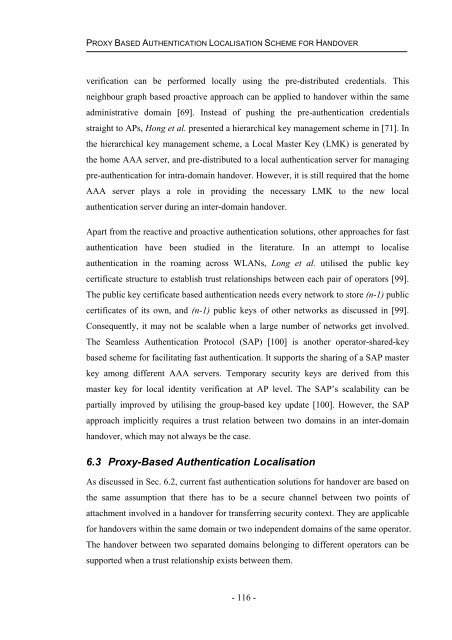Handover mechanisms in next generation heterogeneous wireless ...
Handover mechanisms in next generation heterogeneous wireless ...
Handover mechanisms in next generation heterogeneous wireless ...
You also want an ePaper? Increase the reach of your titles
YUMPU automatically turns print PDFs into web optimized ePapers that Google loves.
PROXY BASED AUTHENTICATION LOCALISATION SCHEME FOR HANDOVER<br />
verification can be performed locally us<strong>in</strong>g the pre-distributed credentials. This<br />
neighbour graph based proactive approach can be applied to handover with<strong>in</strong> the same<br />
adm<strong>in</strong>istrative doma<strong>in</strong> [69]. Instead of push<strong>in</strong>g the pre-authentication credentials<br />
straight to APs, Hong et al. presented a hierarchical key management scheme <strong>in</strong> [71]. In<br />
the hierarchical key management scheme, a Local Master Key (LMK) is generated by<br />
the home AAA server, and pre-distributed to a local authentication server for manag<strong>in</strong>g<br />
pre-authentication for <strong>in</strong>tra-doma<strong>in</strong> handover. However, it is still required that the home<br />
AAA server plays a role <strong>in</strong> provid<strong>in</strong>g the necessary LMK to the new local<br />
authentication server dur<strong>in</strong>g an <strong>in</strong>ter-doma<strong>in</strong> handover.<br />
Apart from the reactive and proactive authentication solutions, other approaches for fast<br />
authentication have been studied <strong>in</strong> the literature. In an attempt to localise<br />
authentication <strong>in</strong> the roam<strong>in</strong>g across WLANs, Long et al. utilised the public key<br />
certificate structure to establish trust relationships between each pair of operators [99].<br />
The public key certificate based authentication needs every network to store (n-1) public<br />
certificates of its own, and (n-1) public keys of other networks as discussed <strong>in</strong> [99].<br />
Consequently, it may not be scalable when a large number of networks get <strong>in</strong>volved.<br />
The Seamless Authentication Protocol (SAP) [100] is another operator-shared-key<br />
based scheme for facilitat<strong>in</strong>g fast authentication. It supports the shar<strong>in</strong>g of a SAP master<br />
key among different AAA servers. Temporary security keys are derived from this<br />
master key for local identity verification at AP level. The SAP’s scalability can be<br />
partially improved by utilis<strong>in</strong>g the group-based key update [100]. However, the SAP<br />
approach implicitly requires a trust relation between two doma<strong>in</strong>s <strong>in</strong> an <strong>in</strong>ter-doma<strong>in</strong><br />
handover, which may not always be the case.<br />
6.3 Proxy-Based Authentication Localisation<br />
As discussed <strong>in</strong> Sec. 6.2, current fast authentication solutions for handover are based on<br />
the same assumption that there has to be a secure channel between two po<strong>in</strong>ts of<br />
attachment <strong>in</strong>volved <strong>in</strong> a handover for transferr<strong>in</strong>g security context. They are applicable<br />
for handovers with<strong>in</strong> the same doma<strong>in</strong> or two <strong>in</strong>dependent doma<strong>in</strong>s of the same operator.<br />
The handover between two separated doma<strong>in</strong>s belong<strong>in</strong>g to different operators can be<br />
supported when a trust relationship exists between them.<br />
- 116 -












